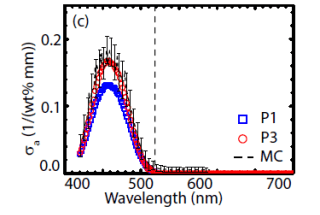Sep 15 2017
Photonics researchers of the University Of Twente and Philips Lighting now prove that white LEDs can be made even more powerful and efficient. They discovered a comprehensive way for describing the light that remains within the LED by absorption and scattering. This is considered to be extremely valuable information for the design process.
 Absorption: blue is based on diffusion theory, red is the new method, black is a numerical 'Monte Carlo' check. Credit: University Of Twente
Absorption: blue is based on diffusion theory, red is the new method, black is a numerical 'Monte Carlo' check. Credit: University Of Twente
From relatively weak light sources to strong lights used in cars and at home, for instance: since the invention of white and blue LEDs, there has been a growing development in promising applications. Long lifetime and low energy consumption are key advantages over the currently available lighting solutions. White LEDs contain a semiconductor emitting blue light, and on top of that phosphor plates that are capable of turning the blue light into yellow. What is seen then is white light. The phosphor particles scatter the light, however part of it is also absorbed. It is difficult to predict what part of the light will exit the LED. Maryna Meretska and her colleagues insist on the need to look at absorption and scattering in another way. Theory from astronomy helps.
Detailed and Fast
What makes good prediction principally difficult: some of the light is absorbed, but emitted again in another color. One way is attempting to define all possible light rays, and make use of a lot of computing time in order to obtain a result. This does not provide much insight in what is actually happening. Diffusion theory is often used for light propagation in an LED. In strongly absorbing media, however, this approach is not considered to be valid anymore. Meretska thus has made a setup for collecting all the light around the phosphor plates, in the whole visual spectrum. Based on this, absorption and scattering can be deduced by employing the radiative transfer equation, commonly known in astronomy. This results in a complete description of light propagation outside and inside the phosphor plates. The absorption level is up to 30% higher when compared to a description using diffusion theory. At the same time, the method is considered to be about 17 times faster than the numerical approach.
These new insights, and their level of detail, can lead to predictive and powerful tools for LED designers. They help in additionally improving the efficiency.
Photonics
The research was performed in the Complex Photonic Systems group of UT’s MESA+ Institute for Nanotechnology, in collaboration with Philips Lighting in Eindhoven. The University of Twente is known to have a strong concentration of research facilities and groups in the rapidly growing field of photonics.
The paper ‘Analytical modeling of light transport in scattering materials with strong absorption’ by Maryna Meretska, Ravitej Uppu, Gilles Vissenberg, Ad Lagendijk, Wilbert IJzerman and Willem Vos, is already available online and will be published in Optics Express, one of the prominent journals of the Optical Society.